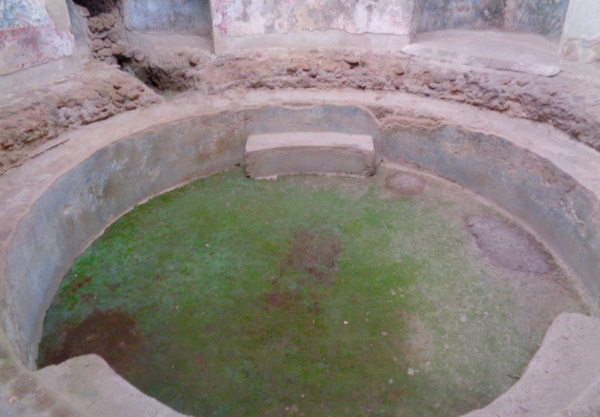As in all Roman cities, there were thermal baths in Pompeii. These are something like public baths. They had mostly pools with warm water, pools with cold water, also a kind of sauna and a gym, thus an antique fitness studio.

The pools were not as big as swimming pools today. They were more for bathing, not for swimming. Men and women were usually separated. There were also, as today, changing rooms. In an adjoining room there was usually an oven that produced the warm water and hot air.
Our tip: Admission prices and tickets for Pompeii 2025The tickets are not quite cheap, but for such a world-famous sight they are not overpriced. Children under the age of 18 are free (ID will be checked). Many visitors buy Pompeii tickets in advance on the Internet, among other things to avoid long queues at the entrance. There is a good website for the online-tickets: Click here |
Thermal baths were very important in ancient Rome, also in the cities of the province like Pompeii. There were many small and large thermal baths, three of which are particularly well known in Pompeii:
The Forum Baths (Terme del Foro): Directly north of the central square of the city (Forum)
Short film 3 min about the Foren-Therme Pompeii (from Youtube)
The Stabian thermal baths: A large complex, one of the most important sights in Pompeii today.
Central Thermae: These large and most modern thermal baths were still under construction during the eruption of the volcano in 79 A.D. and were therefore never completed.
Further article Thermae (Baths) Pompeii
The Baths of Pompeii were the public baths of the ancient Roman city of Pompeii, destroyed by the eruption of Mount Vesuvius in 79 AD. These baths were a central part of daily life in ancient Rome and served not only as bathing facilities, but also as a social meeting place where people gathered and participated in various activities.
The baths of Pompeii had a variety of facilities, including changing rooms, exercise rooms, hot water rooms and cooling rooms. They were heated by a system of underground furnaces and supplied with water from a nearby aqueduct. Inside the baths are ornate decorations and works of art that demonstrate the high level of Roman architecture and engineering. Today, the ruins of the Baths of Pompeii are one of the best-preserved structures of Roman antiquity and offer valuable insights into the daily life and culture of the time. Visitors can see well-preserved rooms and mosaics as well as remains of the heating and water supply systems. The Baths of Pompeii are an important tourist attraction and a valuable resource for historians and archaeologists alike.
Avoid queuing for hours and buy tickets for the excavation of Pompeii in advance on the Internet: Click here
Other articles from us about Pompeii and Herculaneum
Pompeii info (like overview, directions, admission fees, opening hours…)
Brothel Pompeii (Brothel)
Theaters in Pompeii (the 3 big theaters)
Bus Trips Pompeii (from nearby resorts, Naples and Rome)
Herculaneum: The other great ancient city that sank during the volcanic eruption
Corpses Pompeii: All about Corpses and Dead in Pompeii and Herculaneum
Baths in Pompeii (public baths of antiquity)
